History of Zanzibar
| History of Tanzania |
|---|
 |
| Timeline |
| Pre-colonial period |
| Colonial period |
|
| Modern history |
|
|
People have lived in
During the
Sometimes gradually, sometimes by fits and starts, control of Zanzibar came into the hands of the British Empire. In 1890, Zanzibar became a British protectorate. The death of one sultan and the succession of another of whom the British did not approve later led to the Anglo-Zanzibar War, also known as the shortest war in history.
The islands gained independence from Britain in December 1963 as a constitutional monarchy. A month later, the bloody Zanzibar Revolution, in which several thousand Arabs and Indians were killed and thousands more expelled and expropriated, led to the formation of the People's Republic of Zanzibar. That April, the republic merged with the mainland Tanganyika, or more accurately, was subsumed into Tanzania, of which Zanzibar remains a semi-autonomous region. Recent decades in Zanzibar have seen political violence related to contested elections, with a major massacre in 2001.
Prehistory
This section needs additional citations for verification. (July 2020) |
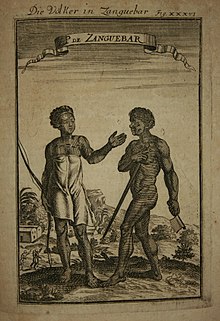
Zanzibar has been inhabited, perhaps not continuously, since the
No cave sites on Zanzibar have revealed pottery fragments used by early and later
Early Trade Routes
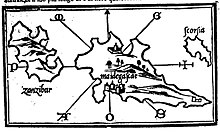

Ancient pottery demonstrates existing trade routes with Zanzibar as far back as the ancient Sumer and Assyria.[2] An ancient pendant discovered near Eshnunna dated ca. 2500-2400 BC. has been traced to copal imported from the Zanzibar region.[3]
Traders from

Traders began to settle in small numbers on Zanzibar in the late 11th or 12th century,
The Yemenis built the earliest
Villages were also present in which lineage groups were common.[citation needed]
Portuguese rule
Vasco da Gama's visit in 1499 marked the beginning of European influence. In 1503 or 1504, Zanzibar became part of the Portuguese Empire when Captain Ruy Lourenço Ravasco Marques landed and demanded and received tribute from the sultan[who?] in exchange for peace.[5] Zanzibar remained a possession of Portugal for almost two centuries.
Zanzibar Sultanate

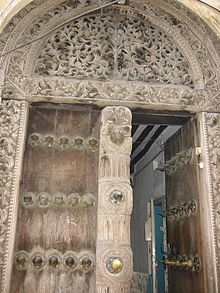
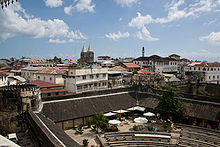
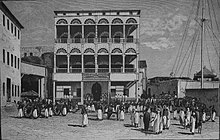


In 1698, Zanzibar fell under the control of the
Accounts by visitors to Zanzibar often emphasize the outward beauty of the place. The British explorer Richard Francis Burton described Zanzibar in 1856 as: "Earth, sea and sky, all seemed wrapped in a soft and sensuous repose...The sea of purist sapphire, which had not parted with its blue rays to the atmosphere...lay looking...under a blaze of sunshine which touched every object with a dull burnish of gold". Adding to the beauty were the gleaming white minarets of mosques and the sultan's palaces in Stone Town, making the city appear from the distance to Westerners as an "Orientalist" fantasy brought to life. Those who got closer described Stone Town as an extremely foul-smelling city that reeked of human and animal excrement, garbage and rotting corpses as garbage, sewage and bodies of animals and slaves were all left out in the open to rot. The British explorer Dr. David Livingstone when living in Stone Town in 1866 wrote in his diary: "The stench arising from a mile and a half or two square miles of exposed sea beach, which is the general depository of the filth of the town is quite horrible...It might be called Stinkabar rather than Zanzibar". Besides for the pervasive foul odor of Stone Town, accounts by visitors described a city full of slaves on the brink of starvation and a place where cholera, malaria, and venereal diseases all flourished.[6]
Of all the forms of economic activity on Zanzibar, slavery was the most profitable and all the blacks living on the island were
The mouth and teeth are inspected, and afterwards every part of the body in succession, not even excepting the breasts, etc, of the girls, many of whom I have seen examined in the most indecent manner in the public market by the purchasers...The slave is then made to walk or run a little way to show that there is no defect about the feet; after which, if the price is agreed to, they are stripped of their finery and delivered over to their future master. I have frequently counted twenty or thirty of these files in the market at one time...Women with children newly born hanging at their breasts and others so old they can scarcely walk, are sometimes seen dragged about in this manner. They had in general a very dejected look; some groups appeared so ill fed that their bones seemed as if ready to penetrate the skin.[7]
Every year, about 40,000-50,000 slaves were taken to Zanzibar. About a third went to work on clove and coconut plantations of Zanzibar and Pemba while the rest were exported to Persia, Arabia, the Ottoman Empire and Egypt. Conditions on the plantations were so harsh that about 30% of the male slaves died every year, thus maintaining the demand for more slaves. The Omani Arabs who ruled Zanzibar had in the words of the American diplomat Donald K. Petterson a "culture of violence", where brute force was the preferred solution to problems and outlandish cruelty was a virtue. The ruling al-Busaid family was characterized by fratricidal quarrels as it was common for brother to murder brother, and this was typical of the Arab aristocracy, where it was acceptable for family members to murder one another to gain land, wealth, titles, and slaves. Visitors to Zanzibar often mentioned the "shocking brutality" which the Arab masters treated their slaves, who were so cowed into submission that there was never a slave revolt attempted on Zanzibar. The cruelty which the Arab masters treated their slaves during the period of slavery on Zanzibar left behind a legacy of hate, which exploded in the revolution of 1964.[7]
The Sultan of Zanzibar controlled a large portion of the
In the late 1800s, the Omani Sultan of Zanzibar also briefly claimed to control
Zanzibar was famous worldwide for its spices and its slaves. During the 19th century, Zanzibar was known all over the world in the words of Petterson as: "A fabled land of spices, a vile center of slavery, a place of origins of expeditions into the vast, mysterious continent, the island was all these things during its heyday in the last half of the 19th century.
Zanzibar had the distinction of having the first
British influence and rule
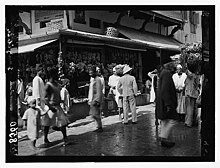
The
The death of
From 1913 until independence in 1963, the British appointed their own residents (essentially governors). One of the more appreciated reforms brought in by the British were the establishment of a proper sewer, garbage disposal system and burial system so that the beaches of Zanzibar reeked no more of bodies, excrement and garbage, finally eliminating the foul smell of Stone Town, which had repulsed so many Western visitors.[13]
Independence and revolution
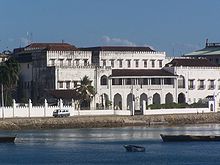
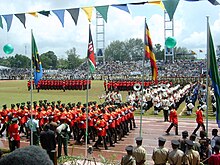
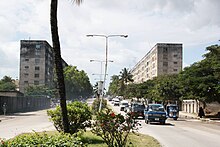
On 10 December 1963, Zanzibar received its independence from the United Kingdom as a
The revolutionary government nationalized the local operations of the two foreign banks in Zanzibar,
One of the main impacts of the revolution in Zanzibar was to break the power of the Arab/Asian ruling class, who had held it for around 200 years.
The government sought help from the Soviet Union, the German Democratic Republic (GDR), and P. R. China for funding for several projects and military advice.
The revolution itself remains an event of interest for Zanzibaris and academics. Historians have analysed the revolution as having a racial and a social basis with some stating that the African revolutionaries represent the proletariat rebelling against the ruling and trading classes, represented by the Arabs and South Asians.[24] Others discount this theory and present it as a racial revolution that was exacerbated by economic disparity between races.[25]
Within Zanzibar, the revolution is a key cultural event, marked by the release of 545 prisoners on its tenth anniversary and by a military parade on its 40th.[26] Zanzibar Revolution Day has been designated as a public holiday by the government of Tanzania; it is celebrated on 12 January each year.[27]
Union with Tanganyika

On 26 April 1964, the mainland colony of
The autonomous status of Zanzibar is viewed as comparable to Hong Kong as suggested by some scholars, and being recognized as the "African Hong Kong".[28]
The Zanzibar House of Representatives was established in 1980. Prior to this, the Revolutionary Council held both the executive and legislative functions for 16 years following the Zanzibar Revolution in 1964.[29]
21st century
There are many political parties in Zanzibar, but the most popular parties are the Chama Cha Mapinduzi (CCM) and the Civic United Front (CUF). Since the early 1990s, the politics of the archipelago have been marked by repeated clashes between these two parties. The results of the past elections held under the multiparty system are as follows:[30]
Political Party
|
Election Year | |||||||
|---|---|---|---|---|---|---|---|---|
| 1995 | 2000 | 2005 | ||||||
| Chama Cha Mapinduzi (CCM) | 26 | 34 | 30 | |||||
| Civic United Front (CUF) | 24 | 16 | 19 | |||||
| Total | 50 | 50 | 50 | |||||
Contested elections in October 2000 led to a massacre on 27 January 2001 when, according to Human Rights Watch, the army and police shot into crowds of protestors, killing at least 35 and wounding more than 600. Those forces, accompanied by ruling party officials and militias, also went on a house-to-house rampage, indiscriminately arresting, beating, and sexually abusing residents. Approximately 2,000 temporarily fled to Kenya.[31]
Violence erupted again after
Following 2005, negotiations between the two parties aiming at the long-term resolution of the tensions and a power-sharing accord took place, but they suffered repeated setbacks. The most notable of these took place in April 2008, when the CUF walked away from the negotiating table following a CCM call for a referendum to approve of what had been presented as a done deal on the power-sharing agreement.[34]
In November 2009, the then-president of Zanzibar, Amani Abeid Karume, met with CUF secretary-general Seif Sharif Hamad at the State House to discuss how to save Zanzibar from future political turmoil and to end the animosity between them.[35] This move was welcomed by many, including the United States.[36] It was the first time since the multi-party system was introduced in Zanzibar that the CUF agreed to recognize Karume as the legitimate president of Zanzibar.[35]
A proposal to amend Zanzibar's constitution to allow rival parties to form governments of national unity was adopted by 66.2 percent of voters on 31 July 2010.[37]
Nowadays,The Alliance for Change and Transparency-Wazalendois (ACT-Wazalendo) is considered the main opposition political party of semi-autonomous Zanzibar. The constitution of Zanzibar requires the party that comes in second in the polls to join a coalition with the winning party. ACT-Wazalendo joined a coalition government with the islands’ ruling party Chama Cha Mapinduzi in December 2020 after Zanzibar disputed elections.[38]
Lists of rulers
Sultans of Zanzibar
- Majid bin Said (1856–1870)
- Barghash bin Said (1870–88)
- Khalifah bin Said (1888–90)
- Ali bin Said (1890–93)
- Hamad bin Thuwaini (1893–96)
- Khalid bin Barghash (1896)
- Hamud bin Muhammed(1896–1902)
- Ali bin Hamud (1902–11; abdicated)
- Khalifa bin Harub (1911–60)
- Abdullah bin Khalifa (1960–63)
- Jamshid bin Abdullah (1963–64)
Viziers
- Sir Lloyd William Matthews (1890 to 1901)
- A.S. Rogers (1901 to 1906)
- Arthur Raikes (1906 to 1908)
- Francis Barton (1906 to 1913)
British residents
- Francis Pearce (1913 to 1922)
- John Sinclair,m (1922 to 1923)
- Alfred Hollis(1923 to 1929)
- Richard Rankine (1929 to 1937)
- John Hall (1937 to 1940)
- Henry Pilling (1940 to 1946)
- Vincent Glenday, 1946 to 1951
- John Rankine(1952 to 1954)
- Henry Steven Potter (1955 to 1959)
- Arthur George Mooring (1959 to 1963)
See also
References
- ^ "Excavations at Kuumbi Cave on Zanzibar 2005", The African Archaeology Network: Research in Progress, Paul Sinclair (Uppsala University), Abdurahman Juma, Felix Chami, 2006
- ISBN 0-7146-1102-6.
- S2CID 161728895.
- ISBN 978-0-19-530173-1
- ISBN 9780714611020– via Google Books.
- ^ a b Petterson, Donald, Revolution In Zanzibar An American's Cold War Tale. New York: Westview, 2002. pp. 6-8.
- ^ a b c d Petterson, pages 23-24.
- ISBN 978-0-8133-7402-4.
- ISBN 978-0-8225-6586-4.
- ^ Petterson, page 4
- ^ National Geographic article
- ^ Remembering East African slave raids BBC
- ^ Petterson, Donald Revolution In Zanzibar An American Cold War's Tale, New York: Westview, 2002 page 7.
- ^ a b c d Triplett 1971, p. 612
- ^ Speller 2007, p. 1
- ^ a b Sadallah, Mwinyi (23 January 2006), "Revert to single party system, CUF Reps say", The Guardian, archived from the original on 2 August 2007, retrieved 14 April 2009.
- ^ Myers 1994, p. 453
- ^ Triplett 1971, p. 613
- ^ Triplett 1971, p. 614
- ^ Triplett 1971, p. 616
- ^ Said, Salma (8 April 2009), "Thousand attend Karume memorial events in Zanzibar", The Citizen, Tanzania, retrieved 14 April 2009[permanent dead link].
- ^ Freedom House (2008), Freedom in the World – Tanzania, retrieved 5 April 2012
- ^ Freedom House (2011), Freedom in the World – Tanzania, retrieved 5 April 2012
- ^ Kuper 1971, pp. 87–88
- ^ Kuper 1971, p. 104
- ^ Kalley, Schoeman & Andor 1999, p. 611
- ^ Commonwealth Secretariat (2005), Tanzania, archived from the original on 1 December 2008, retrieved 10 February 2009
- ^ Simon Shen, One country, two systems: Zanzibar, Ming Pao Weekly, Sep 2016.
- ^ "History of the ZHoR". Zanzibar House of Representatives. Retrieved 15 November 2014.
- ^ "Elections in Zanzibar". Retrieved 15 November 2014.
- ^ "Tanzania: Zanzibar Election Massacres Documented". Human Rights Watch. 10 April 2002. Retrieved 27 August 2010.
- ^ "Nine killed in Zanzibar election violence", Seattle Times, reported by Chris Tomlinson, The Associated Press, 1 November 2005 Archived 6 October 2014 at the Wayback Machine
- ^ "karelprinsloo karel prinsloo". karelprinsloo karel prinsloo.
- ^ "Tanzanian Affairs » ZANZIBAR – A BIG DISAPPOINTMENT".
- ^ a b "Karume: No elections next year in Zanzibar if…", Zanzibar Institute for Research and Public Policy, reported by Salma Said, reprinted from an original article in The Citizen, 19 November 2009
- U.S. Department of State. Archived from the originalon 2011-02-03. Retrieved 27 August 2010.
- ^ "Zanzibar: 2010 Constitutional referendum results" Archived 2016-01-05 at the Wayback Machine, Electoral Institute for the Sustainability of Democracy in Africa, updated August 2010.
- ^ "Zanzibar's opposition party to join coalition government". Associated Press. 6 December 2020.
Sources
- Kalley, Jacqueline Audrey; Schoeman, Elna; Andor, Lydia Eve (1999), Southern African Political History, Greenwood Publishing Group, S2CID 145769109.
- Myers, Garth A. (1994), "Making the Socialist City of Zanzibar", Geographical Review, 84 (4): 451–464, JSTOR 215759.
- Petterson, D. (2002) Revolution In Zanzibar: An American's Cold War Tale, New York: Westview. ISBN 0813342686
- Speller, Ian (2007), "An African Cuba? Britain and the Zanzibar Revolution, 1964.", Journal of Imperial and Commonwealth History, 35 (2): 1–35, S2CID 159656717.
- Triplett, George W. (1971), "Zanzibar: The Politics of Revolutionary Inequality", The Journal of Modern African Studies, 9 (4): 612–617, S2CID 153484206.


